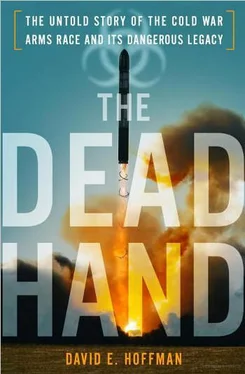It was Gromyko’s last chance to say “nyet.” On June 29, Gorbachev replaced Gromyko as foreign minister, moving him to be chairman of the Supreme Soviet. Gromyko, who held the post twenty-eight years, was a custodian of the old thinking—the world as a collision of two opposing camps—which Gorbachev was about to demolish. Gorbachev then stunned everyone by naming Eduard Shevardnadze, the Georgia party leader, as foreign minister. “This was like a bolt from the blue,” recalled Chernyaev. 31Shevardnadze, who had spent his entire career in Georgia, shared Gorbachev’s understanding of the poverty of the Russian heartland. They stood out from others in the leadership—they did not have experience in heavy industry or the military-industrial complex. 32Shevardnadze had little familiarity with diplomacy, but he was a politician, and he had Gorbachev’s trust. He was promoted immediately to a full Politburo member. In the same session, Gorbachev appointed Lev Zaikov, a Leningrad party official, to oversee the military-industrial complex. Katayev would be one of Zaikov’s key staffers at the Central Committee. “There are many obstacles in this area of our work,” Gorbachev said. “We need to fix things here.” 33
Chernyaev said Soviet propaganda was so stale, no one believed it, “and the root of the Geneva deadlock is this. Revolutionary approaches to talks are needed, identical to the one Gorbachev demonstrated in Leningrad.”
“The question is about the fact that we must stop treading water,” Chernyaev concluded, “as the arms race is about to shoot out of control.” 34
Just after Gorbachev took office, in the spring and early summer of 1985, the directors, designers and constructors of satellites, space boosters, radars and lasers produced a colossal new plan for Gorbachev’s approval. Unknown to the outside world, the Soviet military-industrial complex laid on Gorbachev’s desk a plea for their own “Star Wars.” It came two years after Reagan had announced his Strategic Defense Initiative. It would propel the Soviet Union on the path of previous decades, faithful to the Cold War trajectory of two worlds in collision and ceaseless competition.
Since 1984, the Soviet leadership had been increasingly anxious about Reagan’s dream, and Reagan gave them plenty to worry about. In his second inaugural speech in early 1985, Reagan offered a high-flying description of his program, calling it a global shield to make nuclear weapons obsolete. “I have approved a research program to find, if we can, a security shield that will destroy nuclear missiles before they reach their target,” he said. “It wouldn’t kill people. It would destroy weapons. It wouldn’t militarize space, it would help demilitarize the arsenals of the Earth. It would render nuclear weapons obsolete.”
In Moscow, the KGB made its highest priority gathering intelligence about “American policy on the militarization of space.” That was the title of a ten-page directive issued three and a half weeks after Reagan’s inaugural speech. Soviet spies were ordered to gather intelligence on all the American programs that might deploy systems in space for nuclear and conventional war. They were asked to watch the use of the American space shuttle for deploying weapons in space, the U.S. effort to build an anti-satellite weapon; and they were given extensive tasks to spy on the Strategic Defense Initiative. Woven into the KGB’s instructions were details already plucked from newspapers about Reagan’s program, such as the budget sums and the broad direction, along with ample doses of fear and skepticism about the unknowns. Perhaps Reagan’s program would never work? Perhaps there was a hidden purpose? The KGB was “very anxious to know,” the instruction said, precisely what were the Reagan administration’s plans, how they were evolving, and the “targets, dates and expected financial outlay.” The KGB wanted to know what technical results were achieved in tests, whether it was possible to shoot down a missile using “kinetic weapons,” such as hitting it with another missile or solid object. And what were Reagan’s intentions for negotiating? Was Star Wars really a “large-scale disinformation operation” designed to force the Soviet negotiators into making concessions? 35
An avalanche of intelligence reporting began to flow to Moscow, and stacks of it crossed Katayev’s desk. He observed that the spies were lazy and passive; they often simply sent along press clippings as intelligence. What the agents and Soviet military analysts feared the most, Katayev realized, was to underestimate the seriousness of the threat, so they overestimated it. No one could honestly declare that Star Wars would not work, so they reported that it might. The spies flooded the system with reports of the threat; before long, the military-industrial complex geared up to counter the threat. Starting in 1985 and continuing through the decade, Katayev recalled that about ten cables a day came through his offices in the Central Committee on political-military and technical issues. Of them, 30–40 percent dealt with Star Wars and missile defense. Katayev wondered if the Americans were deliberately trying to choke Moscow with fear by leaking a flood of information. 36In the two years since Reagan’s announcement, the Strategic Defense Initiative was not even close to blueprints—it was still little more than a dream—but it had grabbed the attention of the Soviet leadership.
To build a Soviet Star Wars would mean enormous, lucrative new subsidies for work at the design bureaus, institutes and defense factories. Many of these designers and workers already enjoyed better living conditions than the general population. It was, Katayev recalled, like a hunting dog sensing a new quarry. By summer of 1985, the weapons chiefs pulled together a comprehensive plan for a Soviet missile defense system. According to Katayev’s notebooks and papers, there were two major umbrella programs, each of which included a sprawling array of separate projects ranging from fundamental exploratory research to building equipment ready for flight tests. The two umbrella programs had code names. The first was “D-20,” which included research on ground-based missile defenses and was assigned to the Ministry of Radio Industry, which traditionally had worked on early warning, command and control and the Moscow anti-ballistic missile system. The second was “SK-1000,” a product of the design bureaus of the Ministry of General Machine Building, which oversaw missile and space-related research, development and production. Katayev calculated that altogether the programs would have involved 137 projects in the opytno-konstruktorskie raboty phase, or design and testing; 34 projects in nauchno-issledovatelskiye raboty , or scientific research; and 115 in fundamental science. The estimates of the costs ran into the tens of billions of rubles, enough to keep the design bureaus working full tilt into the late 1980s. Given obscure code names such as Fundament-4 and Integral-3, Onega E, Spiral, Saturn, Kontakt, Echelon and Skif, the programs went on for pages and pages in Katayev’s notebooks. Most of the proposals brought to the Kremlin that summer were intended to produce initial results in 1987–1988; Katayev kept track of goals and targets through 1990. 37
For all the imposing scope and cost, the grand package concealed deep cracks in the system. Some of the programs, started years earlier, lacked results or purpose, or were starved for resources. Some of them were nearly abandoned or obsolete, hoping for a rebirth. SK-1000 included virtually all the space launcher and satellite programs that were underway in the Soviet Union at that time.
One program that illustrated the ambitions, haste and deficiencies that plagued Soviet space weapons builders was an anti-satellite craft known as Skif. The goal of Skif, started in 1976, was to carry a laser in space that could shoot down enemy satellites. The original idea was to build nothing less than a space battle station. It would be hoisted into orbit by the Energia, an enormous booster then under development, and perhaps serviced by the Buran, the planned Soviet space shuttle. By 1984, the Skif program had yet to produce any hardware because there was no laser that would be suitable for space weaponry. The Soviets were shaken that June by news of the successful American missile interception over the Pacific, the lucky single hit, known as the Homing Overlay Experiment, described earlier. Even without a space laser, the government in August ordered creation of a “demonstration” spacecraft, the Skif-D, which would carry a smaller, substitute laser, one that could not shoot down satellites but would at least replicate the original idea. Then, in 1985, came the renewed planning for a Soviet Star Wars. The Skif-D was modified once again. This time it was to be put on an accelerated schedule to fly by the following year. However, the designers still lacked a laser. So they decided to create a mock-up with no functioning laser equipment on board, and called it “Skif-DM.” The vessel was to be 36.9 meters long and weigh 77 tons. The Skif mock-up demonstrator was among those programs offered to Gorbachev for accelerated work in the summer of 1985. 38
Читать дальше












